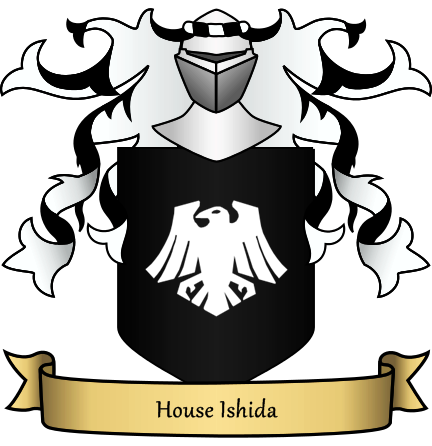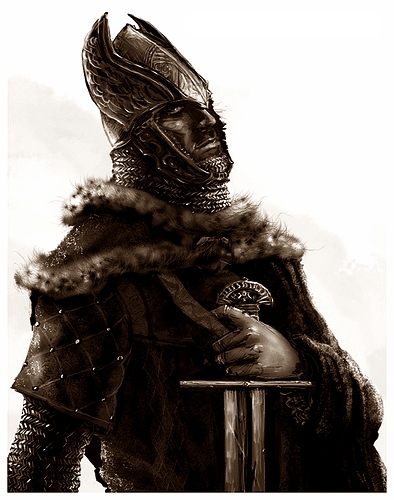Difference between revisions of "Ishida Family"
| Line 51: | Line 51: | ||
| − | House Ishida maintains a standing force known as the '''Ravenguard'''. The Ravenguard is structured into | + | House Ishida maintains a standing force known as the '''Ravenguard'''. The Ravenguard is structured into companies, each led by a noble commander. |
| Line 90: | Line 90: | ||
| − | - '''Mizuhiro Ishida''', Retired from active service | + | - '''Mizuhiro Ishida''', ''Retired from active service'' |
| − | - '''Tetsuko Ishida''', Retired from active service | + | - '''Tetsuko Ishida''', ''Retired from active service'' |
- '''Himeko Ishida''', Beluaterra, Thalmarkin | - '''Himeko Ishida''', Beluaterra, Thalmarkin | ||
| Line 98: | Line 98: | ||
- '''Isamu Ishida''', Atamara, Cagilan Empire | - '''Isamu Ishida''', Atamara, Cagilan Empire | ||
| − | - '''[[/Isao/]] Ishida''', The Far East, Arcaea | + | - '''[[/Isao/]] Ishida''', The Far East, Arcaea (OOC: paused) |
| − | |||
| − | |||
| − | |||
| − | |||
| − | |||
| − | |||
| − | |||
| − | |||
| − | |||
| − | |||
| − | |||
| − | |||
| − | |||
| − | |||
| − | |||
| − | |||
| − | |||
| − | |||
| − | |||
| − | |||
| − | |||
| − | |||
| − | |||
| − | |||
| − | |||
| − | |||
| − | |||
| − | |||
| − | |||
| − | |||
| − | |||
| − | |||
| − | |||
| − | |||
| − | |||
| − | |||
| − | |||
| − | |||
| − | |||
| − | |||
| − | |||
| − | |||
| − | |||
| − | |||
| − | |||
| − | |||
| − | |||
| − | |||
| − | |||
| − | |||
| − | |||
| − | |||
| − | |||
| − | |||
| − | |||
| − | |||
| − | |||
| Line 172: | Line 115: | ||
- '''[[/Ulyssa/]] Ishida''', South Island, Sandalak | - '''[[/Ulyssa/]] Ishida''', South Island, Sandalak | ||
| + | |||
| + | - '''Mayumi Motohisa Ishida''', ''Retired from active service'' | ||
Revision as of 09:29, 27 July 2014
Contents
House Ishida
Origins
The origins of the Ishida are lost to time, but tradition holds that they are descended from a line of Far Eastern nobles who experienced a diaspora generations ago. The main branch of the family has since settled in Atamara, calling itself House Ishida and adopting Atamaran (OOC: Western) norms of culture and tradition.
Present Day
Under the leadership of Mizuhiro House Ishida managed to elevate themselves into prominence. Originally from Sauvia, during the Great Atamaran War Mizuhiro saw fit to relocate the family home and its heirlooms to Craigmore.
The Ishida are fair skinned, with characteristically black hair. Though records suggest that their ancestors possessed oriental looks, the average contemporary Ishida would not look out of place among the nobility of Atamara.
Heraldry
Heraldic device of House Ishida
The heraldic emblem of House Ishida is a stylised raven with outstretched wings. It is often featured as an argent charge upon a sable field.
The Raven is seen as a creature of cunning and intellect, both of which are qualities prized by the Ishida. The Raven is also common sight on the battlefield, a reminder to Ishida nobles that there is much opportunity in war.
The primary colour of House Ishida is black, or sable. This is found most commonly on the cloaks donned by those who serve the House.
Residence
House Ishida's seat is the Ravenholme, an imposing tower built of smooth black rock. Exceedingly lofty in comparison to the structures around it, the Ravenholme is both a fortification and a residence. Barrack spaces and living quarters have been hewn into the walls of the lower levels, ready to house the Ishida's troops as well as provide guest facilities for visiting nobles.
The Ishida themselves occupy the upper floors. Compared to the homes of many noble families, the Ravenholme's interiors possess a slightly darker ambience. Wall-mounted candles provide a measure of light, as many of the lower hallways and rooms have little more than arrow-slits for windows. Furs are a common item, both as decoration and for warmth.
The Ravenguard
A Centurion of the Raven Guard
House Ishida maintains a standing force known as the Ravenguard. The Ravenguard is structured into companies, each led by a noble commander.
Ravenguard Hierarchy
Below the nobles are the Centurions, the Guard equivalent of a Captain. Centurions are hand-picked from the ranks for exceptional leadership and courage in battle.
In times of peace Centurions receive schooling in tactics and philosophy. Such education is costly and difficult to obtain outside of the nobility, and so the rank of Centurion is one that is very much sought after by the common soldiery.
Ravenguard Troops
Infantry and Mixed Infantry
Linesmen make up the majority of the Guard's rank-and-file. The average linesman is equipped with a round shield, axe or (more rarely) short sword. Some commanders may see value in equipping their linesman cohort with light javelins. They are usually armoured in leather or chain mail, depending on the resources available to their commander.
In battle the linesmen are called to do exactly as their name suggests; hold the line. Discipline and cohesion are core tenets of the linesmen cohorts, and reckless bravery is touted as foolish in the face of organised formations. Linesmen tactics commonly involve forming a shield wall with the front ranks while their comrades in the rear fling javelins (when available) to whittle down the enemy before melee.
Ravensworn
There are many in the Guard who aspire to serve as centurions, not a difficult thing to understand given the associated benefits that come from being an officer. Naturally, applicants must undertake a stringent training regime and succeed in a number of tests before they can be counted among the best of the Guard.
Many fail at some point or other, and those who wish to submit their names for another try are allowed to do so on one condition; they must serve for two years with the Ravensworn.
The Ravensworn operate as a tactically flexible light cavalry force, trained primarily for extended sorties and scouting missions, but also to act as mounted skirmishers in battle when needed. Lightly armoured, they are equipped with swords, short bows and light lances to take advantage of their greater mobility.
Due to their nature as failed applicants the Ravensworn are usually called upon for demanding military assignments far from home. These men ride into battles eagerly, hoping to distinguish themselves in the eyes of their commander.
Notable Members
- Mizuhiro Ishida, Retired from active service
- Tetsuko Ishida, Retired from active service
- Himeko Ishida, Beluaterra, Thalmarkin
- Isamu Ishida, Atamara, Cagilan Empire
- Isao Ishida, The Far East, Arcaea (OOC: paused)
Unknown Lineage
The individuals below represent Ishida of unknown (either too minor, or unconfirmed) bloodlines.
Notable Members
- Stillia (Formerly The Silent) Ishida, Dwilight, Swordfell (OOC: Paused)
- Reina Ishida, Dwilight, Fissoa
- Ulyssa Ishida, South Island, Sandalak
- Mayumi Motohisa Ishida, Retired from active service

